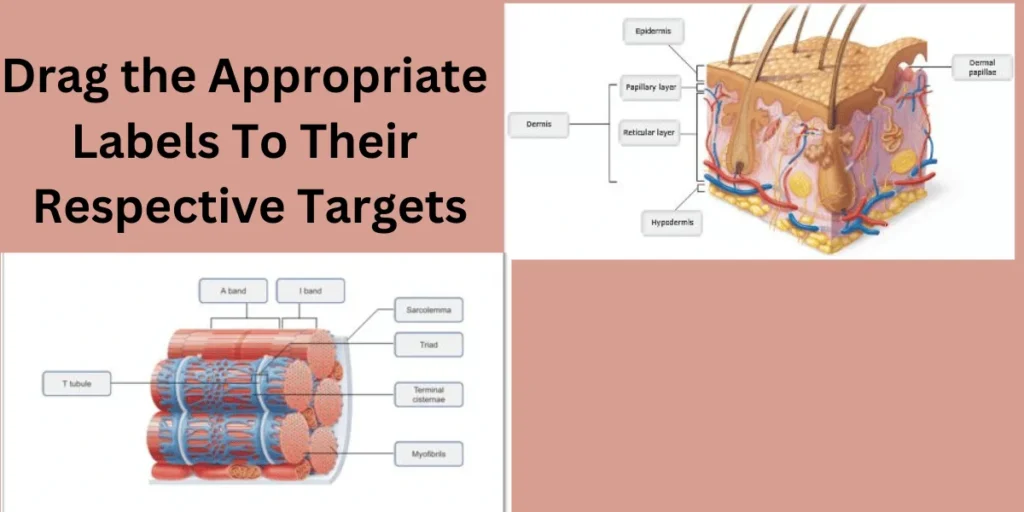In today’s digital age, interactive learning tools have revolutionized the way we engage with educational content. One such method is the “Drag the Appropriate Labels to Their Respective Targets” activity, a popular feature in e-learning platforms, quizzes, and educational games.
This interactive method not only enhances learning but also makes the process more engaging and fun. In this comprehensive guide, we’ll explore what this technique entails, its benefits, and how to implement it effectively.
Also read: ArcyArt Artists Directory | Increaseupcard.org | A Complete Guide | 10.0.0.1 Piso WiFi Pause
What is “Drag the Appropriate Labels To Their Respective Targets”?
“Drag the Appropriate Labels To Their Respective Targets” is an interactive activity commonly used in e-learning modules, educational games, and assessments. It involves dragging and dropping labels or pieces of information to their correct locations or categories. This type of activity is designed to test and reinforce learners’ understanding of concepts, making it an effective tool for knowledge retention.
Key Features of “Drag the Appropriate Labels To Their Respective Targets”
- Interactive Learning: This method requires active participation from the learner, making the learning process more engaging.
- Immediate Feedback: Learners receive instant feedback on their actions, allowing them to correct mistakes and reinforce learning in real-time.
- Versatility: This tool can be used across various subjects and topics, from language learning to science and mathematics.
- Customizability: Educators can tailor these activities to suit the specific needs of their learners, adjusting the difficulty level and content.
How to Implement “Drag the Appropriate Labels To Their Respective Targets”
Implementing “Drag the Appropriate Labels To Their Respective Targets” in an educational setting requires careful planning and execution. Here’s a step-by-step guide to help you create effective and engaging activities.
1. Define the Learning Objectives
Before creating the activity, it’s crucial to define the learning objectives. What do you want your learners to achieve by the end of the exercise? Whether it’s reinforcing vocabulary, understanding a scientific concept, or categorizing historical events, having clear objectives will guide the design of your activity.
2. Choose the Appropriate Content
The content for your “Drag the Appropriate Labels To Their Respective Targets” activity should align with your learning objectives. Choose information that is relevant and challenging, but not overly complex. The content can include text, images, or even audio clips, depending on the subject matter.
3. Design the Layout
The layout of your activity should be intuitive and user-friendly. Clearly define the targets where the labels will be dropped and ensure that the labels are easy to drag. The design should be visually appealing but not distracting, allowing learners to focus on the task at hand.
4. Incorporate Feedback Mechanisms
One of the key benefits of this interactive tool is the ability to provide immediate feedback. Incorporate feedback mechanisms that inform learners whether their choices were correct or incorrect. Positive reinforcement for correct answers and constructive feedback for mistakes can enhance the learning experience.
5. Test the Activity
Before rolling out the activity to learners, it’s essential to test it thoroughly. Ensure that the drag-and-drop functionality works smoothly, and that the feedback is accurate and helpful. Testing also allows you to identify any potential issues with the content or design.
6. Monitor Learner Progress
After implementing the activity, monitor learner progress to assess its effectiveness. Analyze the data to see how learners are performing and make adjustments as needed. This could involve tweaking the difficulty level or providing additional support for learners who are struggling.
Also read: Detroit Tigers vs Minnesota Twins Match Player Stats|San Francisco Giants vs Dodgers Match Player Stats
Benefits of “Drag the Appropriate Labels To Their Respective Targets”
Using “Drag the Appropriate Labels To Their Respective Targets” in educational settings offers several benefits. Here are some key advantages of this interactive learning tool:
1. Enhances Engagement
Traditional learning methods can sometimes be passive, leading to disengagement and reduced retention. “Drag the Appropriate Labels To Their Respective Targets” transforms the learning experience into an active and engaging process. By involving learners directly in the activity, it keeps them focused and interested.
2. Improves Knowledge Retention
The interactive nature of this activity helps reinforce learning. When learners actively participate in the process, they are more likely to remember the information. The immediate feedback provided also aids in correcting misunderstandings, further enhancing retention.
3. Promotes Critical Thinking
“Drag the Appropriate Labels To Their Respective Targets” requires learners to think critically about the information they are presented with. They must analyze the content, make connections, and apply their knowledge to place the labels correctly. This process encourages deeper understanding and critical thinking skills.
4. Adaptable to Different Learning Styles
Every learner is unique, with different preferences and learning styles. “Drag the Appropriate Labels To Their Respective Targets” is adaptable to various learning styles, whether visual, auditory, or kinesthetic. For visual learners, the labels and targets provide a clear, graphic representation of the content. For kinesthetic learners, the physical action of dragging and dropping reinforces learning.
5. Encourages Self-Paced Learning
One of the advantages of e-learning is the ability to learn at one’s own pace. “Drag the Appropriate Labels To Their Respective Targets” allows learners to take their time to understand the content before making their choices. This self-paced approach reduces pressure and allows for more thoughtful engagement with the material.
6. Provides Immediate Feedback
Immediate feedback is crucial in the learning process. It helps learners identify their mistakes and correct them on the spot. This instant reinforcement of correct information or correction of errors is a powerful tool in promoting effective learning.
7. Versatility Across Subjects
“Drag the Appropriate Labels To Their Respective Targets” is a versatile tool that can be used in a wide range of subjects. Whether it’s labeling parts of the human body in a biology class, matching vocabulary words in a language lesson, or categorizing historical events in a history course, this interactive tool can be adapted to fit any curriculum.
8. Builds Confidence
As learners interact with the content and receive immediate feedback, they build confidence in their knowledge and abilities. Successfully completing the activity reinforces their understanding and boosts their self-esteem, encouraging them to take on more challenging tasks.
9. Encourages Collaboration
In a classroom setting, “Drag the Appropriate Labels To Their Respective Targets” can be used as a collaborative activity. Students can work together in pairs or small groups to complete the task, promoting teamwork and communication skills.
10. Supports Formative Assessment
Educators can use “Drag the Appropriate Labels To Their Respective Targets” as a formative assessment tool to gauge learners’ understanding of the material. The data collected from the activity can provide insights into areas where learners may need additional support or instruction.
Best Practices for Using Drag the Appropriate Labels To Their Respective Targets

To maximize the effectiveness of “Drag the Appropriate Labels To Their Respective Targets,” it’s important to follow best practices in its implementation.
1. Keep It Simple and Clear
While it’s important to challenge learners, the activity should not be overly complicated. Keep the instructions clear and straightforward, and ensure that the labels and targets are easily identifiable. Simplicity in design prevents confusion and ensures that learners can focus on the content rather than struggling with the mechanics of the activity.
2. Use Appropriate Content
The content used in the activity should be appropriate for the learners’ level of understanding. Avoid using overly complex or unfamiliar terms, as this can lead to frustration. Instead, choose content that aligns with what has been covered in the course, reinforcing and building on existing knowledge.
3. Provide Hints or Assistance
For more challenging activities, consider providing hints or assistance. This could be in the form of a help button that offers clues, or an option to review relevant content before attempting the activity. Providing support ensures that learners don’t become discouraged and helps them learn from the process.
4. Incorporate Varied Content
To keep the activity engaging, vary the content and format of the labels and targets. This could include using images, diagrams, or audio clips in addition to text. Varied content keeps the activity fresh and interesting, catering to different learning styles.
5. Encourage Reflection
After completing the activity, encourage learners to reflect on their performance. What did they find challenging? What strategies did they use to succeed? Reflection helps consolidate learning and encourages learners to think critically about their approach.
Also read: Milwaukee bucks vs Timberwolves Match Player Stat | process macy’s employee Guide | Clippers vs Okc Thunder Match Player Stats
Conclusion
“Drag the Appropriate Labels To Their Respective Targets” is a powerful interactive learning tool that enhances engagement, improves retention, and promotes critical thinking.
By understanding its benefits and implementing it effectively, educators can create a dynamic and effective learning experience for their students.
Whether used in e-learning modules, classroom activities, or assessments, this technique offers a versatile and adaptable method for reinforcing knowledge and building essential skills.
FAQ: Drag the Appropriate Labels To Their Respective Targets
1. How does “Drag the Appropriate Labels To Their Respective Targets” work?
Participants are presented with labels that need to be moved to specific target areas on the screen. For example, in a biology lesson, you might drag labels like “Heart” or “Lungs” to their correct positions on a diagram of the human body.
2. In what subjects can “Drag the Appropriate Labels To Their Respective Targets” be used?
This activity is versatile and can be used in subjects like language learning, science, mathematics, history, geography, and more. For example, it can be used to label parts of a sentence, categorize animals, or match historical events to their dates.
3. Can this activity be used for all age groups?
Yes, “Drag the Appropriate Labels To Their Respective Targets” can be adapted for different age groups and learning levels. The complexity of the content and the design of the activity can be adjusted to suit young children, teenagers, or adults.






